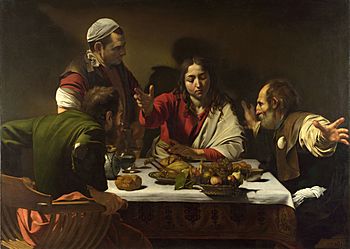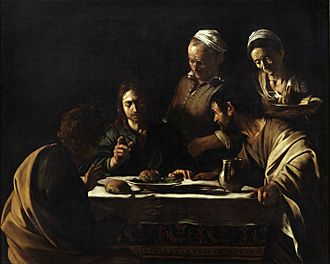Supper at Emmaus (Caravaggio, London) facts for kids
Quick facts for kids Supper at Emmaus |
|
|---|---|
 |
|
| Artist | Caravaggio |
| Year | 1601 |
| Medium | Oil on canvas |
| Dimensions | 141 cm × 196.2 cm (56 in × 77.2 in) |
| Location | National Gallery, London |
The Supper at Emmaus is a famous painting by the Italian artist Caravaggio. He finished it in 1601, and today you can see it in London. This painting shows a story from the Bible where Jesus, after coming back to life, appears to two of his friends in a town called Emmaus.
A man named Ciriaco Mattei asked Caravaggio to paint this artwork. He also paid for it.
What the Painting Shows
This painting captures the moment when Jesus reveals himself to two of his followers. At first, they don't recognize him. These followers are believed to be Luke and Cleopas. The scene takes place in the town of Emmaus. Right after Jesus shows who he is, he disappears from their sight. This story is found in the Gospel of Luke (chapter 24, verses 30–31).
One of the followers, Cleopas, is wearing a scallop shell. This shell was a symbol for people who went on long journeys, called pilgrims. The other follower has clothes that look torn. Cleopas is reaching out his arms in a way that makes it seem like they are coming out of the painting.
The painting is special because the people in it are shown in life-size. The background is dark and plain, which makes the people stand out. On the table, there is a meal with a basket of food that looks like it's about to fall off the edge.
In the Gospel of Mark (chapter 16, verse 12), it says that Jesus appeared to them "in another form." This might be why Caravaggio painted Jesus without a beard in this picture. Usually, Jesus is shown with a beard, like in Caravaggio's painting Calling of St Matthew. Caravaggio often painted everyday moments where something amazing suddenly happens. He seems to suggest that Jesus could appear in our normal lives.
Hidden Meanings
Look closely at the basket of fruit in the front of the painting. Two loose pieces of wicker (the material the basket is made from) form the shape of an ichthys. This is an early Christian symbol that looks like a fish and stands for Christ. Also, the shadow of the fruit on the tablecloth looks like the body and tail of a fish.
Another Version of the Painting
Caravaggio painted another version of The Supper at Emmaus in 1606. This second painting is now in the Brera art gallery in Milan, Italy.
If you compare the two paintings, you'll notice that the people in the Milan version are not making such big, dramatic movements. Their actions are much calmer. This might show how Caravaggio's art style changed over time. Both paintings use a style called Trompe-l'œil. This means the painting tries to trick your eye into thinking things are real or three-dimensional.
See also
 In Spanish: Los discípulos de Emaús (Caravaggio, Londres) para niños
In Spanish: Los discípulos de Emaús (Caravaggio, Londres) para niños


